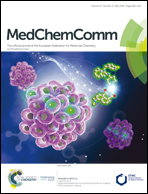Synthesis and biological evaluation of zinc chelating compounds as metallo-β-lactamase inhibitors†
Abstract
The syntheses of metallo-β-lactamase inhibitors comprising chelating moieties, with varying zinc affinities, and peptides partly inspired from bacterial peptide sequences, have been undertaken. The zinc chelator strength was varied using the following chelators, arranged in order of ascending binding affinity: dipicolylamine (DPA, tridentate), dipicolyl-1,2,3-triazolylmethylamine (DPTA, tetradentate) dipicolyl ethylenediamine (DPED, tetradentate) and trispicolyl ethylenediamine (TPED, pentadentate). The chosen peptides were mainly based on the known sequence of the C-terminus of the bacterial peptidoglycan precursors. Biological evaluation on clinical bacterial isolates, harbouring either the NDM-1 or VIM-2 metallo-β-lactamase, showed a clear relationship between the zinc chelator strength and restoration of meropenem activity. However, evaluation of toxicity on different cancer cell lines demonstrated a similar trend, and thus inclusion of the bacterial peptides did possess rather high toxicity towards eukaryotic cells.



 Please wait while we load your content...
Please wait while we load your content...